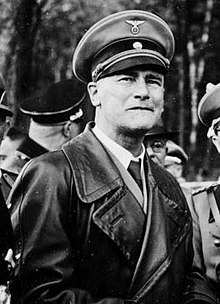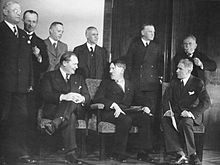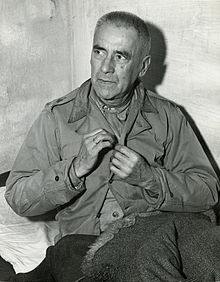Wilhelm Frick
Wilhelm Frick | |
|---|---|
 Frick in 1938 | |
| Reichsminister of the Interior | |
| In office 30 January 1933 – 20 August 1943 | |
| President | Paul von Hindenburg (1933–1934) Adolf Hitler (1934–1943; as Führer) |
| Chancellor | Adolf Hitler |
| Preceded by | Franz Bracht |
| Succeeded by | Heinrich Himmler |
| Protector of Bohemia and Moravia | |
| In office 24 August 1943 – 8 May 1945 | |
| Appointed by | Adolf Hitler |
| Preceded by | Konstantin von Neurath (de jure) Kurt Daluege (de facto) |
| Succeeded by | Position abolished |
| Reichsleiter | |
| In office 10 October 1933 – 8 May 1945 | |
| Appointed by | Adolf Hitler |
| Preceded by | None |
| Succeeded by | Position abolished |
| Personal details | |
| Born | 12 March 1877 Alsenz, Kingdom of Bavaria, German Empire |
| Died | 16 October 1946 (aged 69) Nuremberg, Bavaria, Allied-occupied Germany |
| Nationality | German |
| Political party | Nazi Party |
| Spouses |
|
| Children | 5 |
| Alma mater | |
| Occupation | Attorney |
Wilhelm Frick (12 March 1877 – 16 October 1946) was a prominent German politician of the Nazi Party (NSDAP), who served as Reich Minister of the Interior in Adolf Hitler's cabinet from 1933 to 1943[1] and as the last governor of the Protectorate of Bohemia and Moravia.
As the head of the Kriminalpolizei (criminal police) in Munich, Frick took part in Hitler's failed Beer Hall Putsch of 1923, for which he was convicted of high treason. He managed to avoid imprisonment and soon afterwards became a leading figure of the Nazi Party (NSDAP) in the Reichstag. After Hitler became Chancellor of Germany in 1933, Frick joined the new government and was named Reich Minister of the Interior. He was instrumental in formulating laws that consolidated the Nazi regime (Gleichschaltung), as well as laws that defined the Nazi racial policy, most notoriously the Nuremberg Laws. Following the rise of the SS, Frick gradually lost favour within the party, and in 1943 he was replaced by Heinrich Himmler as interior minister. Frick remained in the cabinet as a minister without portfolio until Hitler's death in 1945.
After World War II, Frick was tried and convicted of war crimes at the Nuremberg trials and executed by hanging.
Early life and family
Frick was born in the Palatinate municipality of Alsenz, then part of the Kingdom of Bavaria, Germany, the last of four children of Protestant teacher Wilhelm Frick sen. (d. 1918) and his wife Henriette (née Schmidt). He attended the gymnasium in Kaiserslautern, passing his Abitur exams in 1896. He went on studying philology at the University of Munich, but soon after turned to study law in Heidelberg and Berlin, taking the Staatsexamen in 1900, followed by his doctorate the next year. Serving as a referendary from 1900, he joined the Bavarian civil service in 1903, working as an attorney at the Munich Police Department. He was appointed a Bezirksamtassessor in Pirmasens in 1907 and became acting district executive in 1914. Rejected as unfit, Frick did not serve in World War I. He was promoted to the official rank of a Regierungsassessor and, at his own request, re-assumed his post at the Munich Police Department in 1917.[2]
On 25 April 1910, Frick married Elisabetha Emilie Nagel (1890–1978) in Pirmasens. They had two sons and a daughter. The marriage ended in an ugly divorce in 1934. A few weeks later, on 12 March, Frick remarried in Münchberg Margarete Schultze-Naumburg (1896–1960), the former wife of the Nazi Reichstag MP Paul Schultze-Naumburg. Margarete gave birth to a son and a daughter.[3]
Nazi career

In Munich, Frick witnessed the end of the war and the German Revolution of 1918–1919. He sympathized with Freikorps paramilitary units fighting against the Bavarian government of Premier Kurt Eisner. Chief of Police Ernst Pöhner introduced him to Adolf Hitler, whom he helped willingly with obtaining permissions to hold political rallies and demonstrations.
Elevated to the rank of an Oberamtmann and head of the Kriminalpolizei (criminal police) from 1923, he and Pöhner participated in Hitler's failed Beer Hall Putsch on 9 November. Frick tried to suppress the State Police's operation, wherefore he was arrested and imprisoned, and tried for aiding and abetting high treason by the People's Court in April 1924. After several months in custody, he was given a suspended sentence of 15 months' imprisonment and was dismissed from his police job. Later during the disciplinary proceedings, the dismissal was declared unfair and revoked, on the basis that his treasonous intention had not been proven. Frick went on to work at the Munich social insurance office from 1926 onwards, in the rank of a Regierungsrat 1st class by 1933.
In the aftermath of the putsch, Wilhelm Frick was elected a member of the German Reichstag parliament in the federal election of May 1924. He had been nominated by the National Socialist Freedom Movement, an electoral list of the far-right German Völkisch Freedom Party and then banned Nazi Party. On 1 September 1925, Frick joined the re-established Nazi Party. He associated himself with the radical Gregor Strasser; making his name by aggressive anti-democratic and antisemitic Reichstag speeches, he climbed to the post of the Nazi parliamentary group leader (Fraktionsführer) in 1928.[4]
In 1929, as the price for joining the coalition government of the Land (state) of Thuringia, the NSDAP received the state ministries of the Interior and Education. On 23 January 1930, Frick was appointed to these ministries, becoming the first Nazi to hold a ministerial-level post at any level in Germany (though he remained a member of the Reichstag).[5] Frick used his position to dismiss Communist and Social Democratic officials and replace them with Nazi Party members, so Thuringia's federal subsidies were temporarily suspended by Reich Minister Carl Severing. Frick also appointed the eugenicist Hans F. K. Günther as a professor of social anthropology at the University of Jena, banned several newspapers, and banned pacifist drama and anti-war films such as All Quiet on the Western Front. He was removed from office by a Social Democratic motion of no confidence in the Thuringian Landtag parliament on 1 April 1931.
Reich Minister

When Reich president Paul von Hindenburg appointed Hitler chancellor on 30 January 1933, Frick joined his government as Reich Minister of the Interior. Together with Reichstag President Hermann Göring, he was one of only two Nazi Reich Ministers in the original Hitler Cabinet, and the only one who actually had a portfolio; Göring served as minister without portfolio until 5 May. Though Frick held a key position, especially in organizing the federal elections of March 1933, he initially had far less power than his counterparts in the rest of Europe. Notably, he had no authority over the police; in Germany law enforcement has traditionally been a state and local matter. Indeed, the main reason that Hindenburg and Franz von Papen agreed to give the Interior Ministry to the Nazis was that it was almost powerless at the time. A mighty rival arose in the establishment of the Propaganda Ministry under Joseph Goebbels on 13 March.
Frick's power dramatically increased as a result of the Reichstag Fire Decree and the Enabling Act of 1933. The provision of the Reichstag Fire Decree giving the cabinet the power to take over state governments on its own authority was actually his idea; he saw the fire as a chance to increase his power and begin the process of Nazifying the country.[6] He was responsible for drafting many of the Gleichschaltung laws that consolidated the Nazi regime.[7] Within a few days of the Enabling Act's passage, Frick helped draft a law appointing Reichskommissare to disempower the state governments. Under the Law for the Reconstruction of the Reich, which converted Germany into a highly centralized state, the newly implemented Reichsstatthalter (state governors) were directly responsible to him. On 10 October 1933, Hitler appointed him a Reichsleiter, the second highest political rank in the Nazi Party. In May 1934, he was appointed Prussian Minister of the Interior under Minister-President Göring, which gave him control over the police in Prussia. By 1935, he also had near-total control over local government. He had the sole power to appoint the mayors of all municipalities with populations greater than 100,000 (except for the city states of Berlin and Hamburg, where Hitler reserved the right to appoint the mayors himself if he deemed it necessary). He also had considerable influence over smaller towns as well; while their mayors were appointed by the state governors, as mentioned earlier the governors were responsible to him.

Frick was instrumental in the racial policy of Nazi Germany drafting laws against Jewish citizens, like the "Law for the Restoration of the Professional Civil Service" and the notorious Nuremberg Laws in September 1935.[4] Already in July 1933, he had implemented the Law for the Prevention of Hereditarily Diseased Offspring including forced sterilizations, which later culminated in the killings of the Action T4 "euthanasia" programme supported by his ministry. Frick also took a leading part in Germany's re-armament in violation of the 1919 Versailles Treaty. He drafted laws introducing universal military conscription and extending the Wehrmacht service law to Austria after the 1938 Anschluss, as well as to the "Sudetenland" territories of the First Czechoslovak Republic annexed according to the Munich Agreement.[8]
In the summer of 1938 Frick was named the patron (Schirmherr) of the Deutsches Turn- und Sportfest in Breslau, a patriotic sports festival attended by Hitler and much of the Nazi leadership. In this event he presided the ceremony of "handing over" the new Nazi Reich Sports League (NSRL) standard to Reichssportführer Hans von Tschammer und Osten, marking the further nazification of sports in Germany.[9] On 11 November 1938, Frick promulgated the Regulations Against Jews' Possession of Weapons.
From the mid-to-late 1930s Frick lost favour irreversibly within the Nazi Party after a power struggle involving attempts to resolve the lack of coordination within the Reich government.[10] For example, in 1933 he tried to restrict the widespread use of "protective custody" orders that were used to send people to concentration camps, only to be begged off by Reichsführer-SS Heinrich Himmler. His power was greatly reduced in June 1936 when Hitler named Himmler the Chief of German Police, which effectively united the police with the SS. On paper, Frick was Himmler's immediate superior. In fact, the police were now independent of Frick's control, since the SS was responsible only to Hitler.[11][12] A long-running power struggle between the two culminated in Frick's being replaced by Himmler as Minister of the Interior in 1943. However, he remained in the cabinet as a minister without portfolio. Besides Hitler, he and Lutz Graf Schwerin von Krosigk were the only members of the Third Reich's cabinet to serve continuously from Hitler's appointment as Chancellor until his death.
Frick's replacement as Reich Minister of the Interior did not reduce the growing administrative chaos and infighting between party and state agencies.[13] Frick was then appointed as Protector of Bohemia and Moravia, making him Hitler's personal representative in the Czech Lands. Its capital Prague, where Frick used ruthless methods to counter dissent, was one of the last Axis-held cities to fall at the end of World War II in Europe.[14]
Trial and execution


Frick was arrested and tried before the Nuremberg trials, where he was the only defendant besides Rudolf Hess who refused to testify on his own behalf.[15] Frick was convicted of planning, initiating and waging wars of aggression, war crimes and crimes against humanity, and for his role in formulating the Enabling Act as Minister of the Interior and the Nuremberg Laws – under these laws people were deported to concentration camps, and many of those were murdered there. Frick was also accused of being one of the highest persons responsible for the existence of the concentration camps.[8]
Frick was sentenced to death on 1 October 1946, and was hanged at Nuremberg Prison on 16 October. Of his execution, journalist Joseph Kingsbury-Smith wrote:
The sixth man to leave his prison cell and walk with handcuffed wrists to the death house was 69-year-old Wilhelm Frick. He entered the execution chamber at 2.05 am, six minutes after Rosenberg had been pronounced dead. He seemed the least steady of any so far and stumbled on the thirteenth step of the gallows. His only words were, "Long live eternal Germany," before he was hooded and dropped through the trap.[16][17]
His body, as those of the other nine executed men and the corpse of Hermann Göring, was cremated at Ostfriedhof (Munich) and the ashes were scattered in the river Isar.[18][19][20]
See also
Notes and references
- ^ Claudia Koonz, The Nazi Conscience, p 103, ISBN 0-674-01172-4
- ^ Biographie, Deutsche. "Frick, Wilhelm - Deutsche Biographie". www.deutsche-biographie.de.
- ^ "Deutsches Historisches Museum: Fehler2". www.dhm.de.
- ^ a b "Index Fo-Fy". rulers.org.
- ^ "Nurnbergprocessen 1". www.bjornetjenesten.dk.
- ^ Evans, Richard J. (2003). The Coming of the Third Reich. New York City: Penguin Press. ISBN 978-0141009759.
- ^ "Nazi Party organizations, Reich Interior Minister: Wilhelm Frick (1933–1943)".
- ^ a b "Nuremberg Trial Defendants: Wilhelm Frick". www.jewishvirtuallibrary.org.
- ^ Dr. Frick presiding the Breslau Games
- ^ A legalistic follower, rather than an initiator, Frick the servant increasingly lost favour with his master, apparently because he misunderstood the basic nature of the Fuhrer's governance. Whereas the Third Reich thrived on inconsistencies, rivalries, and constant evolutionary change, Frick's juristic mind longed for order and legal stabilization. The incongruity was insuperable and it was thus logical enough that in 1943 the minister, whose share of practical power had rapidly diminished in the second half of the 1930s, ultimately even lost his official post.Udo Sautter, Canadian Journal of History
- ^ Longerich, Peter (2012). Heinrich Himmler: A Life, Oxford University Press, p. 204.
- ^ Williams, Max (2001). Reinhard Heydrich: The Biography: Volume 1, Ulric, p. 77.
- ^ Hans Mommsen, The Dissolution of the Third Reich (1943–1945) Archived 7 August 2008 at the Wayback Machine
- ^ Trial:Wilhelm Frick Archived 2 December 2008 at the Wayback Machine
- ^ "The trial of German major war criminals : proceedings of the International Military Tribunal sitting at Nuremberg Germany". avalon.law.yale.edu.
- ^ Joseph Kingsbury-Smith, who witnessed the execution of Wilhelm Frick and nine other leaders of the Nazi Party on 1st October 1946 Archived 24 October 2008 at the Wayback Machine
- ^ Today, one can see Wilhelm Frick's military dress uniform at Motts Military Museum in Groveport, Ohio. The uniform was found in his home shortly after Frick was arrested in 1945. The soldier who found and brought the items home was a member of the CIC (Counter Intelligence Corps). Richard Roberts was an attorney from Columbus, Ohio who spent the war years in espionage and counter intelligence.
- ^ Thomas Darnstädt (2005), "Ein Glücksfall der Geschichte", Der Spiegel, 13 September, no. 14, p. 128
- ^ Manvell 2011, p. 393.
- ^ Overy 2001, p. 205.
Further reading
External links
- 1877 births
- 1946 deaths
- People from Donnersbergkreis
- Christian fascists
- German Protestants
- German Völkisch Freedom Party politicians
- National Socialist Freedom Movement politicians
- Nazi Party politicians
- Nazis who participated in the Beer Hall Putsch
- Nazi Germany ministers
- People executed by the International Military Tribunal in Nuremberg
- People from the Palatinate (region)
- People from the Kingdom of Bavaria
- Protectorate of Bohemia and Moravia
- Heidelberg University alumni
- German people convicted of the international crime of aggression
- German people convicted of crimes against humanity
- Executed people from Rhineland-Palatinate
- Holocaust perpetrators in Germany
- Thule Society members
- Jurists from Rhineland-Palatinate
- Lawyers in the Nazi Party
- Nazi Party officials
- Members of the Reichstag of the Weimar Republic
- Members of the Reichstag of Nazi Germany
- German nationalists
- People executed for crimes against humanity
